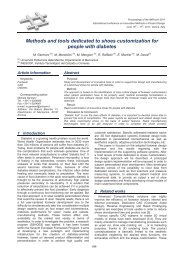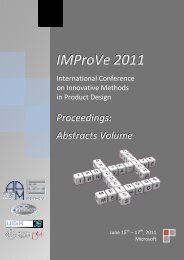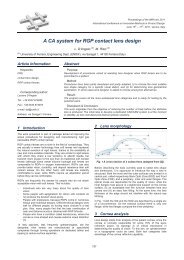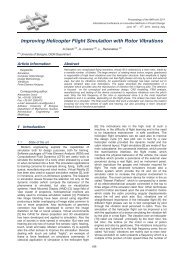IMProVe 2011 - Proceedings
IMProVe 2011 - Proceedings
IMProVe 2011 - Proceedings
You also want an ePaper? Increase the reach of your titles
YUMPU automatically turns print PDFs into web optimized ePapers that Google loves.
Design Methods and Applications<br />
generators units to reduce drag in heavy trucks. In both cases, the involved aerodynamic<br />
phenomena will be comprehensively characterized in laboratory.<br />
Special emphasis was put in the development of prototypes which were able to allow us<br />
making a wide number of distinct alternatives with low building costs. Thus, modular<br />
designs based on the quick exchange between parts, were carried out. In addition, simple<br />
geometry components and basic mechanical systems were proposed. In the two cases, up<br />
to 400 different configurations of study were obtained.<br />
Keywords: Physical prototype, Modular design, Alternatives of study, Aerodynamic<br />
phenomena<br />
Corresponding Author: José Luis Santolaya<br />
Tel.:+34 976 761900<br />
Fax.: +34 976 762235<br />
e-mail: jlsanto@unizar.es<br />
Address: C/ María de Luna, 3 - (50018) Zaragoza - Spain.<br />
Design optimization based on eco-design<br />
and mechanical analysis<br />
I. Lopez (a), R. Miralbes (a)<br />
(a) Design and Manufacture Engineering Department. University of Zaragoza (Spain)<br />
Abstract:<br />
The work presented here attempts to show the advantages of relating design tools and<br />
methods that impact on improvement methodology and outcome of product design, in<br />
this case eco-design and the mechanical analysis are related in order to optimize the<br />
design to generate a lower environmental impact without loss of functional performance.<br />
The methodology proposes a market survey to select the objects to analyze, in which<br />
observe the environmental impact analysis with a specific tool so the ranges of optimal<br />
values in production, use and disposal of values and objectives and as the use of ecodesign<br />
strategies are set. At the same time, a mechanical study using reverse engineering,<br />
loads and stress analysis, by means of finite elements that just results in a number of<br />
conditions and values to be taken into account in future design.<br />
Once the research and analysis raises the design stage in which proposals are made, those<br />
are analyzed using the same tools, in terms of environmental impact and structural<br />
strength, to establish more robust design from a series of alternative proposals according<br />
to predetermined design criteria.<br />
This work aims to link the findings of both analysis so as to enable optimum results and<br />
compatible design specifications and thus show the current need to develop hybrid<br />
methods that relate to the different techniques and tools.<br />
June 15 th – 17 th , <strong>2011</strong>, Venice, Italy<br />
103<br />
<strong>IMProVe</strong> <strong>2011</strong> - <strong>Proceedings</strong>










